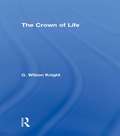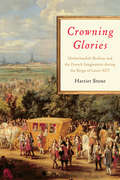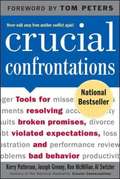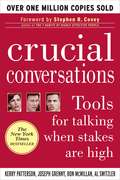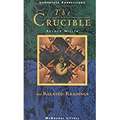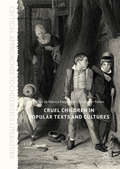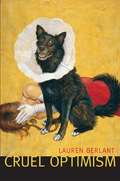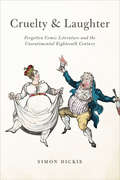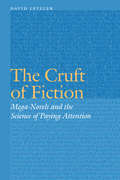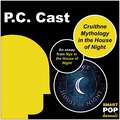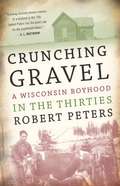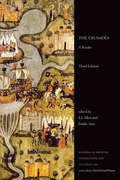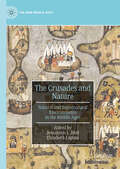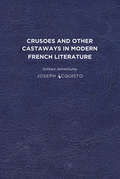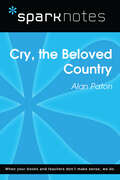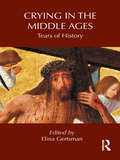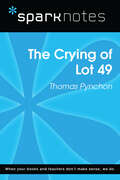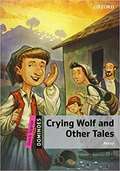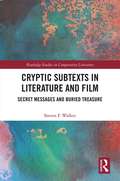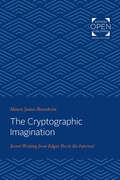- Table View
- List View
Crown Of Life - Wilson Knight: Essays In Interpretation Of Shakespeare's Final Plays (University Paperbacks Ser.)
by G. Wilson KnightFirst published in 2002. Routledge is an imprint of Taylor & Francis, an informa company.
Crowning Glories: Netherlandish Realism and the French Imagination during the Reign of Louis XIV
by Harriet StoneCrowning Glories integrates Louis XIV’s propaganda campaigns, the transmission of Northern art into France, and the rise of empiricism in the eighteenth century – three historical touchstones – to examine what it would have meant for France’s elite to experience the arts in France simultaneously with Netherlandish realist painting. In an expansive study of cultural life under the Sun King, Harriet Stone considers the monarchy’s elaborate palace decors, the court’s official records, and the classical theatre alongside Northern images of daily life in private homes, urban markets, and country fields. Stone argues that Netherlandish art assumes an unobtrusive yet, for the history of ideas, surprisingly dramatic role within the flourishing of the arts, both visual and textual, in France during Louis XIV’s reign. Netherlandish realist art represented thinking about knowledge that challenged the monarchy’s hold on the French imagination, and its efforts to impose the king’s portrait as an ideal and proof of his authority. As objects appreciated for their aesthetic and market value, Northern realist paintings assumed an uncontroversial place in French royal and elite collections. Flemish and Dutch still lifes, genre paintings, and cityscapes, however, were not merely accoutrements of power, acquisitions made by those with influence and money. Crowning Glories reveals how the empirical orientation of Netherlandish realism exposed French court society to a radically different mode of thought, one that would gain full expression in the Encyclopédie of Diderot and d’Alembert.
Crucial Confrontations: Tools for Resolving Broken Promises, Violated Expectations, and Bad Behavior
by Kerry Patterson Joseph Grenny Ron Mcmillan Al Switzler Tom PetersThe authors of the New York Times bestseller Crucial Conversations show you how to achieve personal, team, and organizational success by healing broken promises, resolving violated expectations, and influencing good behavior Discover skills to resolve touchy, controversial, and complex issues at work and at home--now available in this follow-up to the internationally popular Crucial Conversations. Behind the problems that routinely plague organizations and families, you'll find individuals who are either unwilling or unable to deal with failed promises. Others have broken rules, missed deadlines, failed to live up to commitments, or just plain behaved badly--and nobody steps up to the issue. Or they do, but do a lousy job and create a whole new set of problems. Accountability suffers and new problems spring up. New research demonstrates that these disappointments aren't just irritating, they're costly--sapping organizational performance by twenty to fifty percent and accounting for up to ninety percent of divorces. Crucial Confrontations teaches skills drawn from 10,000 hours of real-life observations to increase confidence in facing issues like: An employee speaks to you in an insulting tone that crosses the line between sarcasm and insubordination. Now what? Your boss just committed you to a deadline you know you can't meet--and not-so-subtly hinted he doesn't want to hear complaints about it. Your son walks through the door sporting colorful new body art that raises your blood pressure by forty points. Speak now, pay later. An accountant wonders how to step up to a client who is violating the law. Can you spell unemployment? Family members fret over how to tell granddad that he should no longer drive his car. This is going to get ugly. A nurse worries about what to say to an abusive physician. She quickly remembers "how things work around here" and decides not to say anything. Everyone knows how to run for cover, or if adequately provoked, step up to these confrontations in a way that causes a real ruckus. That we have down pat. Crucial Confrontations teaches you how to deal with violated expectations in a way that solves the problem at hand, and doesn't harm the relationship--and in fact, even strengthens it. Crucial Confrontations borrows from twenty years of research involving two groups. More than 25,000 people helped the authors identify those who were most influential during crucial confrontations. They spent 10,000 hours watching these people, documented what they saw, and then trained and tested with more than 300,000 people. Second, they measured the impact of crucial confrontations improvements on organizational and team performance--the results were immediate and sustainable: twenty to fifty percent improvements in measurable performance.
Crucial Conversations: Tools for Talking When Stakes Are High
by Kerry Patterson Joseph Grenny Ron Mcmillan Al Switzler Stephen R. CoveyFour cofounders of a corporate consulting firm present their formula for effective communication, based on the trial and error of years spent as corporate trainers. The reader is drilled not only in communication skills but also to recognize bad or shifty modes of communication, to develop integrity in word and deed, and to achieve more effective work habits. Annotation c. Book News, Inc., Portland, OR (booknews.com)
The Crucible
by McDougal-Littell Publishing StaffA textbook reader for young adults features Arthur Miller's "The Crucible," plus short stories, poems, and essays designed to build reading comprehension.
The Crucible of Language
by Vyvyan EvansFrom the barbed, childish taunt on the school playground, to the eloquent sophistry of a lawyer prising open a legal loophole in a court of law, meaning arises each time we use language to communicate with one another. How we use language - to convey ideas, make requests, ask a favour, and express anger, love or dismay - is of the utmost importance; indeed, linguistic meaning can be a matter of life and death. In The Crucible of Language, Vyvyan Evans explains what we know, and what we do, when we communicate using language; he shows how linguistic meaning arises, where it comes from, and the way language enables us to convey the meanings that can move us to tears, bore us to death, or make us dizzy with delight. Meaning is, he argues, one of the final frontiers in the mapping of the human mind.
The Crucible SparkNotes Literature Guide (SparkNotes Literature Guide Series #24)
by SparkNotesThe Crucible SparkNotes Literature Guide by Arthur Miller Making the reading experience fun! When a paper is due, and dreaded exams loom, here's the lit-crit help students need to succeed! SparkNotes Literature Guides make studying smarter, better, and faster. They provide chapter-by-chapter analysis; explanations of key themes, motifs, and symbols; a review quiz; and essay topics. Lively and accessible, SparkNotes is perfect for late-night studying and paper writing. Includes:An A+ Essay—an actual literary essay written about the Spark-ed book—to show students how a paper should be written.16 pages devoted to writing a literary essay including: a glossary of literary termsStep-by-step tutoring on how to write a literary essayA feature on how not to plagiarize
Cruel Children in Popular Texts and Cultures (Critical Approaches to Children's Literature)
by Monica Flegel Christopher ParkesThis book explores how alarmist social discourses about 'cruel' young people fail to recognize the complexity of cruelty and the role it plays in child agency. Examining representations of cruel young people in popular texts and popular culture, the collected essays demonstrate how gender, race, and class influence who gets labeled 'cruel' and which actions are viewed as negative, aggressive, and disruptive. It shows how representations of cruel young people negotiate the violence that shadows polite society, and how narratives of cruelty and aggression are used to affirm, or to deny, young people’s agency.
Cruel Optimism
by Lauren BerlantA relation of cruel optimism exists when something you desire is actually an obstacle to your flourishing. Offering bold new ways of conceiving the present, Lauren Berlant describes the cruel optimism that has prevailed since the 1980s, as the social-democratic promise of the postwar period in the United States and Europe has retracted. People have remained attached to unachievable fantasies of the good life--with its promises of upward mobility, job security, political and social equality, and durable intimacy--despite evidence that liberal-capitalist societies can no longer be counted on to provide opportunities for individuals to make their lives "add up to something."Arguing that the historical present is perceived affectively before it is understood in any other way, Berlant traces affective and aesthetic responses to the dramas of adjustment that unfold amid talk of precarity, contingency, and crisis. She suggests that our stretched-out present is characterized by new modes of temporality, and she explains why trauma theory--with its focus on reactions to the exceptional event that shatters the ordinary--is not useful for understanding the ways that people adjust over time, once crisis itself has become ordinary. Cruel Optimism is a remarkable affective history of the present.
Cruelty and Laughter: Forgotten Comic Literature and the Unsentimental Eighteenth Century
by Simon DickieEighteenth-century British culture is often seen as polite and sentimental--the creation of an emerging middle class. Simon Dickie disputes these assumptions in Cruelty and Laughter, a wildly enjoyable but shocking plunge into the forgotten comic literature of the age. Beneath the surface of Enlightenment civility, Dickie uncovers a rich vein of cruel humor that forces us to recognize just how slowly ordinary human sufferings became worthy of sympathy. Delving into an enormous archive of comic novels, jestbooks, farces, variety shows, and cartoons, Dickie finds a vast repository of jokes about cripples, blind men, rape, and wife-beating. Epigrams about syphilis and scurvy sit alongside one-act comedies about hunchbacks in love. He shows us that everyone--rich and poor, women as well as men--laughed along. In the process, Dickie also expands our understanding of many of the century's major authors, including Samuel Richardson, Lady Mary Wortley Montagu, Tobias Smollett, Frances Burney, and Jane Austen. He devotes particular attention to Henry Fielding's Joseph Andrews, a novel that reflects repeatedly on the limits of compassion and the ethical problems of laughter. Cruelty and Laughter is an engaging, far-reaching study of the other side of culture in eighteenth-century Britain.
Cruelty & Laughter: Forgotten Comic Literature and the Unsentimental Eighteenth Century
by Simon DickieEighteenth-century British culture is often seen as polite and sentimental—the creation of an emerging middle class. Simon Dickie disputes these assumptions in Cruelty and Laughter, a wildly enjoyable but shocking plunge into the forgotten comic literature of the age. Beneath the surface of Enlightenment civility, Dickie uncovers a rich vein of cruel humor that forces us to recognize just how slowly ordinary human sufferings became worthy of sympathy.Delving into an enormous archive of comic novels, jestbooks, farces, variety shows, and cartoons, Dickie finds a vast repository of jokes about cripples, blind men, rape, and wife-beating. Epigrams about syphilis and scurvy sit alongside one-act comedies about hunchbacks in love. He shows us that everyone—rich and poor, women as well as men—laughed along. In the process, Dickie also expands our understanding of many of the century’s major authors, including Samuel Richardson, Lady Mary Wortley Montagu, Tobias Smollett, Frances Burney, and Jane Austen. He devotes particular attention to Henry Fielding’s Joseph Andrews, a novel that reflects repeatedly on the limits of compassion and the ethical problems of laughter. Cruelty and Laughter is an engaging, far-reaching study of the other side of culture in eighteenth-century Britain.
The Cruft of Fiction: Mega-Novels and the Science of Paying Attention (Frontiers of Narrative)
by David LetzlerA 2017 Choice Outstanding Academic Title What is the strange appeal of big books? The mega-novel, a genre of erudite tomes with encyclopedic scope, has attracted wildly varied responses, from fanatical devotion to trenchant criticism. Looking at intimidating mega-novel masterpieces from The Making of Americans to 2666, David Letzler explores reader responses to all the seemingly random, irrelevant, pointless, and derailing elements that comprise these mega-novels, elements that he labels “cruft” after the computer science term for junk code. In The Cruft of Fiction, Letzler suggests that these books are useful tools to help us understand the relationship between reading and attention.While mega-novel text is often intricately meaningful or experimental, sometimes it is just excessive and pointless. On the other hand, mega-novels also contain text that, though appearing to be cruft, turns out to be quite important. Letzler posits that this cruft requires readers to develop a sophisticated method of attentional modulation, allowing one to subtly distinguish between text requiring focused attention and text that must be skimmed or even skipped to avoid processing failures. The Cruft of Fiction shows how the attentional maturation prompted by reading mega-novels can help manage the information overload that increasingly characterizes contemporary life.
Cruithne Mythology and the House of Night
by PC CastFrom Nyx in the House of Night: Mythology, Folklore, and Religion in the P.C. and Kristin Cast Vampyre Series: P.C. Cast relates her inspiration for the setting of the House of Night and how Scottish and Irish history are woven into the series.
Crunching Gravel: A Wisconsin Boyhood in the Thirties
by Robert PetersNo nostalgic tale of the good old days, Robert Peters’s recollections of his adolescence vividly evoke the Depression on a hardscrabble farm near Eagle River: Dad driving the Vilas County Relief truck, Lars the Swede freezing to death on his porch, the embarassment of graduation in a suit from welfare. The hard efforts to put fish and potatoes and blueberries on the table are punctuated by occasional pleasures: the Memorial Day celebration, swimming at Perch Lake, the county fair with Mother’s prizes for jam and the exotic delights of the midway. Peters’s clear-eyed memoir reveals a poet’s eye for rich and stark detail even as a boy of twelve. “Peters misses nothing, from the details of the town’s Fourth of July celebration to the cause and effect of a young cousin’s suicide to the calibrations of racism toward Indians that was so acceptable then. It is a fascinating, unsentimental look at a piece of our past. ”—Margaret E. Guthrie,New York Times Book Review “It’s unlikely that any other contemporary poet and scholar as distinguished has risen from quite so humble beginnings as Robert Peters. Born and raised by semiliterate parents on a subsistence farm in northeastern Wisconsin, Peters lived harrowingly close to the eventual stuff of his poetry—the dependency of humans on animal lives, the inexplicable and ordinary heroism and baseness of people facing extreme conditions, the urgency of physical desire. . . . Sterling childhood memoirs. ”—Booklist “Robert Peters has written a memoir exemplary because he insists on the specific, on the personal and the local. It is also enormously satisfying to read, and it is among the most authentic accounts of childhood and youth I know—a Wisconsin David Copperfield!”—Thom Gunn
A Crusader's Death and Life in Acre: The 1266 Account-Inventory of Eudes of Nevers (Medieval Societies, Religions, and Cultures)
by Anne E. Lester Laura K. MorrealeA Crusader's Death and Life in Acre uses five parchment rolls that inventoried the possessions of Eudes of Nevers, son of the duke of Burgundy, at his death in Acre in 1266 to open out a panorama of Christian crusader life. The contents of the rolls, or rouleaux, span from the pay rendered to knights and servants to the numerous possessions of a crusading nobleman. The inventory provides insight into the medieval Outremer even as it provokes questions about trade, diplomacy, remembrance, and the methodological challenges of evoking material objects in texts. Anne E. Lester and Laura K. Morreale present the first complete modern French edition and English translation of the rouleaux along with seven crusade poems by Rutebeuf. In addition, A Crusader's Death and Life in Acre contains a wealth of scholarly commentary that addresses the composition of the rouleaux, the life and relationships of Eudes, and the culture of crusading in its material, written, devotional, and poetic forms.Contributors: Sharon Farmer, Andrew Jotischky, Anne Latowsky, Richard A. Leson, Maureen C. Miller, Jonathan Rubin, Uri Zvi Shachar, and Caroline Smith
The Crusades: A Reader, Third Edition (Readings in Medieval Civilizations and Cultures #VIII)
by S. J. Allen Emilie AmtSince its first appearance in 2004, The Crusades: A Reader has been the go-to sourcebook in the field. S.J. Allen and Emilie Amt cover the entire crusading movement, from its origins to its modern afterlife, using key primary source documents. The third edition features a new introduction that includes a guide for students on how to use the book. The editors have also added more content on women, material culture, Jewish and Byzantine perspectives, Muslim-Crusader interactions, and modern use of Crusade imagery and rhetoric by the Far Right. The geographic range is broad, covering not only Crusades in the Middle East, but also in Spain and in northern Europe and against European heretics. While scholarship, courses, and textbooks on the Crusades have proliferated over the past twenty years, The Crusades: A Reader remains the only comprehensive, up-to-date, and in-print sourcebook available on the subject.
The Crusades and Nature: Natural and Supernatural Environments in the Middle Ages (The New Middle Ages)
by Elizabeth Lapina Jessalynn L. BirdThe Crusades and Nature: Natural and Supernatural Environments in the Middle Ages explores the intersection of crusader studies and studies of nature. The volume addresses encounters with, responses to and representations of a broad variety of phenomena: celestial objects and events; familiar and unfamiliar fauna and flora; seascapes and landscapes; the elements and the seasons; etc. It introduces readers to crusaders’ actual, but also largely or entirely imaginary encounters with natural phenomena, as well as literary references to nature in crusader sources more generally (such as, for example, animal metaphors). Finally, this project investigates the relationships between the natural and the supernatural and between nature and human-made environments. The volume will define “crusades” broadly, to include not only crusades to the East, but also crusades to frontier regions such as the Baltic and Iberian peninsula and extends to representations of crusades and nature in later medieval and early modern sources.
Crusoes and Other Castaways in Modern French Literature: Solitary Adventures
by Joseph AcquistoCrusoes and Other Castaways in Modern French Literature: Solitary Adventures by Joseph Acquisto examines the many ways in which the castaway, particularly in the form of engagement with Robinson Crusoe, has been reinterpreted and appropriated in nineteenth through twenty-first century French literature. The book is not merely a literary history of the robinsonnade in France; rather, Acquisto demonstrates how what he calls the genre of “solitary adventure” becomes a vehicle for exploration of much larger questions about the reception of texts, modes of reading, and the relationship between popular and serious literary traditions. The heart of Crusoes and Other Castaways in Modern French Literature examines a crucial moment in the late nineteenth and early twentieth centuries when the history of cultural perspectives on reading and solitude intersect, catalyzing a reconsideration of Defoe’s tale. Acquisto’s philosophically inflected readings of works by writers from Rousseau to Balzac, Verne to Gide, Valéry to Tournier enhance intertextual and cultural approaches to the castaway myth and broaden our appreciation of the dynamic relation it has to modern French literature writ large. Published by University of Delaware Press. Distributed worldwide by Rutgers University Press.
Cry, the Beloved Country (SparkNotes Literature Guide Series)
by SparkNotesCry, the Beloved Country (SparkNotes Literature Guide) by Alan Paton Making the reading experience fun! Created by Harvard students for students everywhere, SparkNotes is a new breed of study guide: smarter, better, faster.Geared to what today's students need to know, SparkNotes provides:chapter-by-chapter analysis explanations of key themes, motifs, and symbols a review quiz and essay topics Lively and accessible, these guides are perfect for late-night studying and writing papers.
Crying in the Middle Ages: Tears of History (Routledge Studies in Medieval Religion and Culture)
by Elina GertsmanSacred and profane, public and private, emotive and ritualistic, internal and embodied, medieval weeping served as a culturally charged prism for a host of social, visual, cognitive, and linguistic performances. Crying in the Middle Ages addresses the place of tears in Jewish, Christian, and Islamic cultural discourses, providing a key resource for scholars interested in exploring medieval notions of emotion, gesture, and sensory experience in a variety of cultural contexts. Gertsman brings together essays that establish a series of conversations with one another, foregrounding essential questions about the different ways that crying was seen, heard, perceived, expressed, and transmitted throughout the Middle Ages. In acknowledging the porous nature of visual and verbal evidence, this collection foregrounds the necessity to read language, image, and experience together in order to envision the complex notions of medieval crying.
The Crying of Lot 49 (SparkNotes Literature Guide Series)
by SparkNotesThe Crying of Lot 49 (SparkNotes Literature Guide) by Thomas Pynchon Making the reading experience fun! Created by Harvard students for students everywhere, SparkNotes is a new breed of study guide: smarter, better, faster.Geared to what today's students need to know, SparkNotes provides:chapter-by-chapter analysis explanations of key themes, motifs, and symbols a review quiz and essay topics Lively and accessible, these guides are perfect for late-night studying and writing papers.
Crying Wolf and Other Tales
by Hardy-Gould JanetCrying Wolf (Part 1 & 2); The Goose with the Golden Eggs (Part 1 & 2); The Bear and the Two Travelers (Part 1 & 2).
Cryptic Subtexts in Literature and Film: Secret Messages and Buried Treasure
by Steven F WalkerOne of the primary objectives of comparative literature is the study of the relationship of texts, also known as intertextuality, which is a means of contextualizing and analyzing the way literature grows and flourishes through inspiration and imitation, direct or indirect. When the inspiration and imitation is direct and obvious, the study of this rapport falls into the more restricted category of hypertextuality. What the author has labeled a cryptic subtext, however, is an extreme case of hypertextuality. It involves a series of allusions to another text that have been deliberately inserted by the author into the primary text as potential points of reference. This book takes a deep dive into a broad array of literature and film to explore these allusions and the hidden messages therein.
The Cryptographic Imagination: Secret Writing from Edgar Poe to the Internet (Parallax: Re-visions of Culture and Society)
by Shawn James RosenheimOriginally published in 1996. In The Cryptographic Imagination, Shawn Rosenheim uses the writings of Edgar Allan Poe to pose a set of questions pertaining to literary genre, cultural modernity, and technology. Rosenheim argues that Poe's cryptographic writing—his essays on cryptography and the short stories that grew out of them—requires that we rethink the relation of poststructural criticism to Poe's texts and, more generally, reconsider the relation of literature to communication. Cryptography serves not only as a template for the language, character, and themes of much of Poe's late fiction (including his creation, the detective story) but also as a "secret history" of literary modernity itself. "Both postwar fiction and literary criticism," the author writes, "are deeply indebted to the rise of cryptography in World War II." Still more surprising, in Rosenheim's view, Poe is not merely a source for such literary instances of cryptography as the codes in Conan Doyle's "The Dancing-Men" or in Jules Verne, but, through his effect on real cryptographers, Poe's writing influenced the outcome of World War II and the development of the Cold War. However unlikely such ideas sound, The Cryptographic Imagination offers compelling evidence that Poe's cryptographic writing clarifies one important avenue by which the twentieth century called itself into being. "The strength of Rosenheim's work extends to a revisionistic understanding of the entirety of literary history (as a repression of cryptography) and then, in a breathtaking shift of register, interlinks Poe's exercises in cryptography with the hyperreality of the CIA, the Cold War, and the Internet. What enables this extensive range of applications is the stipulated tension Rosenheim discerns in the relationship between the forms of the literary imagination and the condition of its mode of production. Cryptography, in this account, names the technology of literary production—the diacritical relationship between decoding and encoding—that the literary imagination dissimulates as hieroglyphics—the hermeneutic relationship between a sign and its content."—Donald E. Pease, Dartmouth College
Cryptography: A Very Short Introduction
by Fred Piper Sean MurphyProvide information about cryptography, gives tips and techniques.
